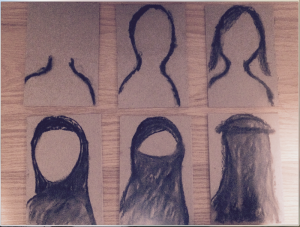Charcoal Forms
I created these tiles with charcoal in response to my reading of Persepolis. As I was reading the book, I found myself connecting with the narrator on many intrinsic levels. Though I did not understand the extent of her situation, her vitality stuck out to me. She had this intense will, even wanting to be a prophet at some point, and I think that there is something very beautiful in this will. Furthermore, she lived during a period when wearing the hijab became mandatory, where even the most modern and radical women dared only show a few strands of hair. I think that the role of the narrator was detrimental; without her age and the youthful turbulence that took place during the times of revolution and islamization, the story would have carried a completely different message. For me, because I had so many connections with her, I wanted to create a piece that revealed the true similarities that we all share.
With charcoal and some brown slates, I begin to draw the progression of a person: beginning the first tile with the shoulder line and ending the last tile with a full burka. The keys were the constant black lining as well as the lack of facial distinctions. I think that regardless of what one wears on their head, if they choose to wear anything at all, there is so much more to a human being than the physical features. In removing their eyes and noses and mouths, one may say that I was restricting them of their identities. But instead, I believe that focusing so much on physical beauty and hair and the sexualization of the body is what removes identity. I believe that what matters is voice. And I could not draw voice. And a burka should not cover voice. And if a girl wants to be a prophet, who should stop her? No one. If a girl wants to show her full head of hair, or if a girl wants to keep her burka on, I don’t think it is anybody else decision. I don’t think anybody else has control of the body, and to try to assume this control is a betrayal of voices. I chose to leave ambiguity in the face to create discomfort. I don’t think we should ever allow ourselves to be comfortable, either as Westerners or non-Westerners, and assume that anything is the way it should be. We cannot say that somebody is not allowed to wear what they wish to wear; nor is anyone else allowed to force the body into hiding. There are many ways of hiding, but I don’t think that the physical manifestations of the hidden are the ones we should be paying attention to. Instead: how do we hide voices?


Love the art and design
Graphic Artist said this on February 11th, 2017 at 7:53 pm